

Ideally, the education of children should integrate their intellectual, physical, emotional and spiritual development. However, present day education is primarily focused on academic achievement with some additional emphasis on sport and physical education. The emotional and spiritual development of children tends to receive less attention.
Education has two important aspects: intellectual and skill development focused upon learning about the world outside, and personal development focused upon learning about the world within. Education about the outer world helps the child to acquire various skills which eventually help them to earn a living. Education about the world within, or personal development, helps children to learn an art of living whereby they can live a balanced and productive life based in positive actions and harmonious relationships.
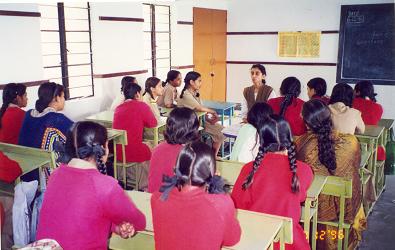 Introductory class for Anapana meditation in India
Introductory class for Anapana meditation in India
A child can be well trained in the acquisition of various skills so that he or she may become a successful professional, but when the learning about the world within is neglected, we get a society dealing with the problems of anger, violence, anxiety, depression and anti-social behaviour.
Parents and teachers often realize that something is lacking in education, but do not know what to do about it. Because most countries have a secular public education system, the solution to teaching personal growth and development to children needs to be a non-sectarian one.
Inner Education through Anapana Meditation
We could enhance the education of the child by introducing a learning method that will encourage personal growth and help them develop into a mature and balanced individual. Such a method would assist in creating an intelligence which is born of self-awareness and self-knowing. This type of learning has to be at the experiential level and cannot be learned from reading books.
Ideally this learning would be imbibed with a scientific attitude and a spiritual intent. By "spiritual" what is meant here is the true spiritual mind which is independent of any particular cult, group, religion or organized belief system.
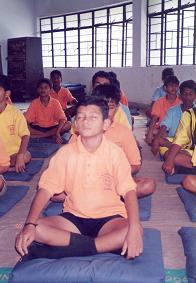 Introductory class for Anapana meditation in India
From experience in conducting children's courses in meditation, we observe that children experience tangible growth at an inner level when they are taught in a specialized environment, which helps them to take their first steps into the world within.
Introductory class for Anapana meditation in India
From experience in conducting children's courses in meditation, we observe that children experience tangible growth at an inner level when they are taught in a specialized environment, which helps them to take their first steps into the world within.
The focus of these courses is Anapana meditation. In a nutshell, this technique develops the ability to live in the present moment, and gradually removes complexes and negativities latent in the children's minds.
Anapana meditation is a simple, non-sectarian technique. It involves awareness of natural respiration, which means that children from any part of the world, from any background, can successfully learn it, without controversy. The children learn to watch the incoming breath and outgoing breath by focusing their attention at the entrance of their nostrils. They simply observe their natural breath without trying to change or correct the flow of the breath. In this way, they experience the beginning steps of self-awareness.
As they observe, they learn to be in the present. The mind gradually becomes more calm and focused. Once they begin this learning, it does not end. The capacity to live in the present in a balanced manner makes every moment of life a moment of growth.
Organization of Children's Courses
Children who come to one-day, two-day or three-day Anapana courses follow a schedule of meditation interspersed with other activities. The aim is to make the meditation an appealing activity for the children. Communication is a means to satisfy their natural inquisitiveness. Small groups of children are guided by a teacher who is a Vipassana meditator. Constant interaction with the children ensures that they grasp the essence of the technique. The entire timetable is organized to supplement the meditation.
Meditation periods last for about half an hour. They are punctuated by group discussions, games and creative activities, all of which aim at encouraging the expression of originality in each child. Hence along with the actual practice of the meditation, the children experience its practical value while participating in various activities.
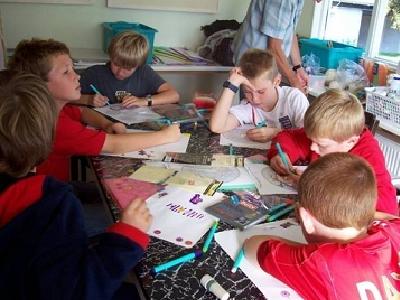 Creative activities at children's course in UK
Creative activities at children's course in UK
By developing direct experience, a secular spirit and a scientific attitude, the child learns an art of developing mastery over his or her mind. He or she learns that the breath is a bridge between the body and mind, and that the rhythm of the breath is closely related to the state of mind. Over time, the awareness of natural, normal, breath helps the child to come out of such unbalanced mental states as anxiety, fear, anger, etc.
Anapana, like any other technique, slowly becomes a part of life with daily practice. The mind becomes positive and alert, making the child ready to face the challenges he or she has to encounter in day-to-day life.
The children's courses as taught today have evolved from many years of practical experience. Ideally three-day courses are held at the meditation centres for different age groups. Experience has shown that the residential courses are suitable for children aged eight year and over. So the following age groups have been devised:
Younger group: 8 to 12 years
Older group: 13 to 16 years (or up to 18 in some countries).
After 18 years, young people are considered ready to undertake a full ten-day Vipassana course. Children from all backgrounds are welcome to attend Anapana courses. Those who have a Vipassana meditator in the family, or for whom Anapana meditation is part of the school curriculum are especially encouraged. This is because the benefits of meditation are greatly enhanced when the practice becomes a part of the child's daily life.
While three-day Anapana course for children are organized at Vipassana centres, one or two-day residential course are organized in schools. An important prerequisite for a course to be offered in a given school is that the school have at least one teacher who has done a ten-day Vipassana course. In addition, it is preferable that the school should be willing to set aside 10-15 minutes a day for meditation practice.
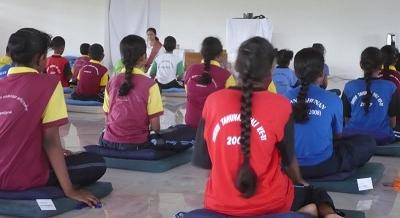 Course for a Tamil school group at Vipassana Centre in Malaysia
Course for a Tamil school group at Vipassana Centre in Malaysia
Some Experiences
In a day school in Hyderabad, India, Anapana courses have been conducted regularly since February 1991. Each year the children of class III (8 years old) are introduced to meditation, and now classes III, IV, and V are meditating regularly. They meditate for five minutes after morning assembly and for five minutes before they go home in the evening. At first the principal and some of the teachers were skeptical about how beneficial only five minutes of meditation could be. However they were surprised to discover how much better behaved the children became.
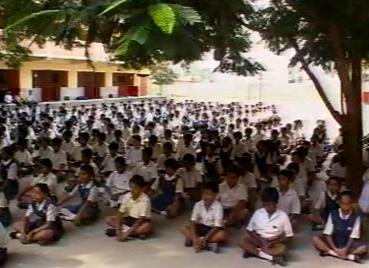
Meditation at morning assembly in India
Questionnaires have been sent to the parents and class teachers to evaluate the changes in the children's behaviour and academic achievement. From the replies to the questionnaires, it can be concluded that children first improve in their social behaviour. Negative qualities like quarrelsomeness, use of harsh words, being disruptive in class and various complexes decrease. Simultaneously, positive qualities such as helpfulness, cleanliness and self-confidence increase. Memory, concentration and grades also improve.
Learning Anapana meditation will enrich the spiritual and emotional lives of children. Furthermore, it is a practical, non-sectarian technique that can benefit all, irrespective of their cultural or religious backgrounds. May children everywhere experience the benefits of this practice.